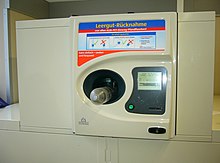Empties machine

An empties machine (also a deposit machine , deposit return machine ) is used to take back empty beverage packaging that is subject to a deposit , such as reusable bottles or beverage cans . Empty vending machines are often found in supermarkets , beverages and hypermarkets , where they replace the empty container acceptors previously served by staff.
functionality
The empties (in beverage crates and as individual bottles ) are scanned, weighed and automatically checked for returnability using pattern recognition . After completing the return, the customer receives a printout at the push of a button on which a barcode (retailer-specific area of the EAN system) contains the deposit value encoded. The value of the deposit is offset at the scanner cash register or paid out in cash.
With appropriately equipped machines, the accepted empties can be automatically sorted into separate containers according to criteria such as type of container, material, color in order to facilitate further processing. The average price of an empties machine is 25,000 euros. Manufacturers of empties machines are z. B. Tomra from Norway and Diebold from Germany.
development
The first patent for an empties machine was granted in the USA in 1920. ("Bottle Return and Handling Machine"). The first functioning empties machine for glass bottles was developed by the Swedish company Wicanders in the late 1950s. In 1962 the Norwegian Aage Tveitan developed an improved empties machine and manufactured it with his company Arthur Tveitan ASA.
At the beginning of the 1990s, there was an attempt to create an incentive to return beverage cans with a competition at the empties machine . With the introduction of the bottle deposit in Germany in 2003, can sales fell and so did interest in this kind of gamification of the return of empties.
Since the one-way deposit reform of May 1, 2006, modern empties machines also recognize one-way beverage packaging from other manufacturers and reimburse the customer for the deposit. This was done first by checking the EAN code of the bottle against a database of bottles subject to deposit. Due to the possibility of manipulation, this very insecure procedure was replaced in autumn 2006 by the recognition of the deposit logo printed in a special security color by the company Deutsche Pfandsystem GmbH (DPG), which is responsible for processing the one-way deposit throughout Germany . But critics also criticize the lack of security in this successor system.
The automated detection obliges every retailer who carries one-way bottles to take back all bottles. However, the take-back obligation is limited to bottles of the same material ( e.g. PET ). The new empties machines require Internet access or a LAN connection to the retailer's IT systems in order to exchange data with the DPG deposit clearing offices (so-called clearing offices ). The machine reports data on the type and number of returned packaging and is supplied with data on the packaging to be accepted (in particular its EAN code). In order to avoid multiple deposit refunds for the same packaging and to save transport costs, most empties machines for one-way drinks packaging have a device that presses the bottles into a flat shape ("compacts") or shreds them into small pieces.
Web links
Individual evidence
- ^ About Reverse Vending Machines . Reverse vending. Retrieved September 12, 2014.
- ↑ Garbage quota ten to one . In: Der Spiegel, No. 06/1992, February 3, 1992.
- ↑ Security technology for deposit systems is being retrofitted , Heise online , April 28, 2006; total December 29, 2008